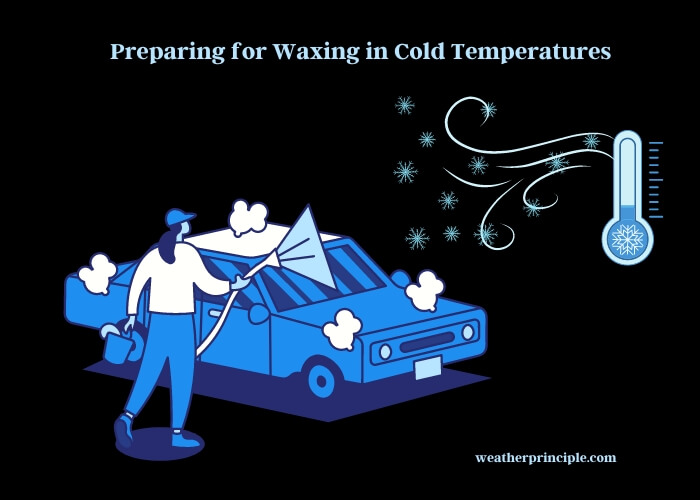Published on: July 26, 2023
Written by Shaown Khan / Fact-checked by Kader Khan
Yes, you can wax your car in 40-degree weather. This temperature is generally considered ideal for car waxing.
The key to a successful car waxing lies in selecting an appropriate temperature. While the best temperature to polish a car isn’t set in stone, most professionals suggest a range of 60 to 80 degrees Fahrenheit. That being said, 40 degrees isn’t far off this range and can still yield good results. The primary concern in colder weather is the wax’s ability to bond effectively with the car’s surface, so choosing the best car wax for cold weather is crucial.

If the temperature is too high, say around 90 degrees or higher, it might be too hot to wax a car. The heat can cause the wax to dry too quickly, making it difficult to remove and potentially damaging the car’s finish. On the contrary, very low temperatures can make the wax too hard to apply smoothly. Hence, it’s clear that temperature plays a significant role in car waxing.
The best time of year to wax a car is usually spring and fall when the weather conditions are generally moderate. Using cold weather car wax during winter months can protect your vehicle from the harsh elements and road salts that can cause corrosion and damage. A good quality winter car wax can create a protective layer against these elements, preserving the appearance and value of your car.
Similarly, in terms of body care, the best temperature for waxing legs and other body parts is usually around the same range as for car waxing. The wax should be warm enough to spread smoothly but not so hot as to cause burns or discomfort. It’s all about finding a balance that works well for the task at hand.
Car Wax: Defining its Functionality
Car Wax: Its Definition
Car wax is a protective coating applied to a vehicle’s surface. This specialized product shields the paintwork from dirt, moisture, sunlight, and other environmental factors. It provides a lustrous shine, enhances the vehicle’s appearance, and prolongs the life of the car’s paintwork.
Benefits of Using Car Wax
Waxing a car isn’t just about aesthetics, it also provides practical advantages. It forms a barrier against harmful elements like UV rays, rain, snow, and road salt. It also shields against minor scratches, bird droppings, and tree sap. A good wax job makes it harder for dirt and grime to stick, making your car easier to clean.
The Effect of Temperature on Car Wax Application
Correlation Between Wax Application and Temperature
Temperature plays a key role in car wax application. Too hot, and the wax dries too quickly, making it difficult to buff off. Too cold, and it may not bond properly to the vehicle’s surface. Therefore, the right temperature ensures the wax adheres perfectly to give a nice, glossy finish.
Ideal Conditions for Waxing a Car
The perfect conditions for waxing a car are typically between 55 and 85 degrees Fahrenheit. In these moderate temperatures, the wax has enough time to bond with the car’s surface without drying too quickly.
| Temperature | Waxing Condition |
| Below 50°F | Not Recommended |
| 50 – 70°F | Good |
| 70 – 90°F | Ideal |
| Above 90°F | Not Recommended |
Waxing a Car in 40 Degree Weather: Practical or Not?
Influence of 40-Degree Weather on Wax Application
Waxing your car in 40-degree weather isn’t ideal. The cold temperature could affect the wax’s ability to bond properly with the car’s surface. If the wax can’t adhere correctly, it might not provide the protective layer needed or the glossy finish desired.
Pros and Cons of Waxing in This Weather
Waxing your car in 40-degree weather has its own set of challenges and advantages. On the one hand, the cold temperature might mean the wax takes longer to dry, giving you more time to work. On the other hand, the wax might not adhere properly, leading to a less effective wax job.
Hazards of Waxing a Car in Cold Weather
Identifying Potential Risks
One risk is that the wax could streak or become blotchy due to the cold, leading to a less than perfect finish. Also, applying wax in cold weather could lead to it not curing properly, reducing its durability and protective properties.
Stories from Real-Life Experiences
There are numerous stories of car owners experiencing the drawbacks of waxing in cold weather. Some find the wax hard to remove, others notice a dull finish instead of the usual shine.
| Case | Outcome |
| John waxed his car in 40-degree weather | The wax was difficult to buff off |
| Mary applied wax during a cold spell | The finish was dull and streaky |
Preparing for Waxing in Cold Temperatures
Pre-Wax Preparation Procedures
Before waxing in cold weather, make sure your car is clean and dry. Any dirt or moisture on the surface can interfere with the wax’s ability to adhere. Consider warming up your car slightly before you start to help the wax bond better.

Selecting the Appropriate Wax for Cold Temperatures
Some waxes are better suited to colder conditions than others. Synthetic waxes, for example, are often more flexible in their application temperatures and can work well even in colder weather.
Detailed Guide to Waxing a Car in 40 Degree Weather
Necessary Tools and Materials
You’ll need car wax suitable for cold weather, a wax applicator pad, a microfiber towel for buffing, and gloves to keep your hands warm.
Steps for Successful Wax Application
First, apply a small amount of wax to the applicator pad. Working in sections, spread the wax on the car’s surface using circular motions. Allow it to dry, then buff off with the microfiber towel.
| Step | Description |
| 1 | Apply wax to applicator pad |
| 2 | Spread wax on car’s surface |
| 3 | Let wax dry |
| 4 | Buff off wax |
Maintaining Your Car’s Wax Coat in Cold Weather
Post-Wax Maintenance
After waxing your car, be gentle with it for a few days. Avoid driving in harsh conditions if possible, and definitely avoid using an automatic car wash, as the bristles can strip the fresh wax off.
Indications That Your Wax Coat Needs Care
If your car’s finish doesn’t bead water as it used to, or if it starts looking dull, it might be time to wax again. Regular maintenance can keep your car looking its best, even in cold weather.
Alternatives to Outdoor Waxing in Cold Weather
Professional Services as an Option
If the weather is simply too cold for an outdoor DIY job, consider turning to professionals. Many detailing services offer waxing, and their indoor facilities can provide the perfect temperature for a great wax job.
Indoor Facilities for Car Waxing
Waxing your car indoors is an excellent alternative if you have access to a suitable space. A garage, for instance, can provide a controlled environment that is warmer than the outside, ensuring the wax bonds properly to your car’s surface.
Expert Tips for Car Waxing in Cold Weather
Insights from Professionals
Professionals often suggest using a synthetic wax in cold weather because it’s easier to work with and less likely to leave streaks. They also recommend warming the car slightly before waxing to ensure the wax bonds properly.
Common Mistakes to Sidestep
Common pitfalls to avoid include not thoroughly cleaning the car before waxing, applying the wax too thickly, and not allowing it enough time to dry before buffing it off. These mistakes can compromise the quality and durability of the wax job.
FAQs
Is It Too Cold to Wax My Car?
Yes, it can be too cold to wax your car. Below 50 degrees Fahrenheit, the wax may not bond properly with the car’s surface, leading to ineffective protection and a lackluster finish.
What Is the Best Wax for Winter?
Synthetic waxes are often the best for winter. They offer more flexibility in application temperatures and can work well even in colder weather, providing the necessary protection for your car.
Can You Wax Your Car in the Winter?
Yes, you can wax your car in the winter, although it’s more challenging. The wax might take longer to dry and may not bond properly with the car’s surface. Using a synthetic wax and ensuring the car is clean and slightly warm can help.
What Is the Lowest Temperature to Wax a Car?
The lowest recommended temperature to wax a car is typically around 50 degrees Fahrenheit. Below this temperature, the wax may not bond effectively with the car’s surface, diminishing its protective properties and visual appeal.
Can I Wax My Car in Cold Weather?
Yes, you can wax your car in cold weather, but it requires special care. Synthetic waxes are preferable, and the car should be clean and slightly warmed before application.
Can You Wax a Car in 50 Degree Weather?
Yes, you can wax a car in 50-degree weather, although it’s not ideal. The wax should be applied in a thinner layer than usual and allowed plenty of time to dry before buffing.
What Is the Best Car Wax for Cold Weather?
The best car wax for cold weather is typically a synthetic wax. It offers more flexibility in application temperatures, can bond effectively with the car’s surface even in the cold, and provides the necessary protection against harsh winter conditions.
So there you have it – waxing a car in 40-degree weather is a challenging task, but with the right precautions and techniques, it can be done effectively. Always remember to use a suitable wax, take your time, and consider professional help if necessary. Happy waxing!
Read more:



